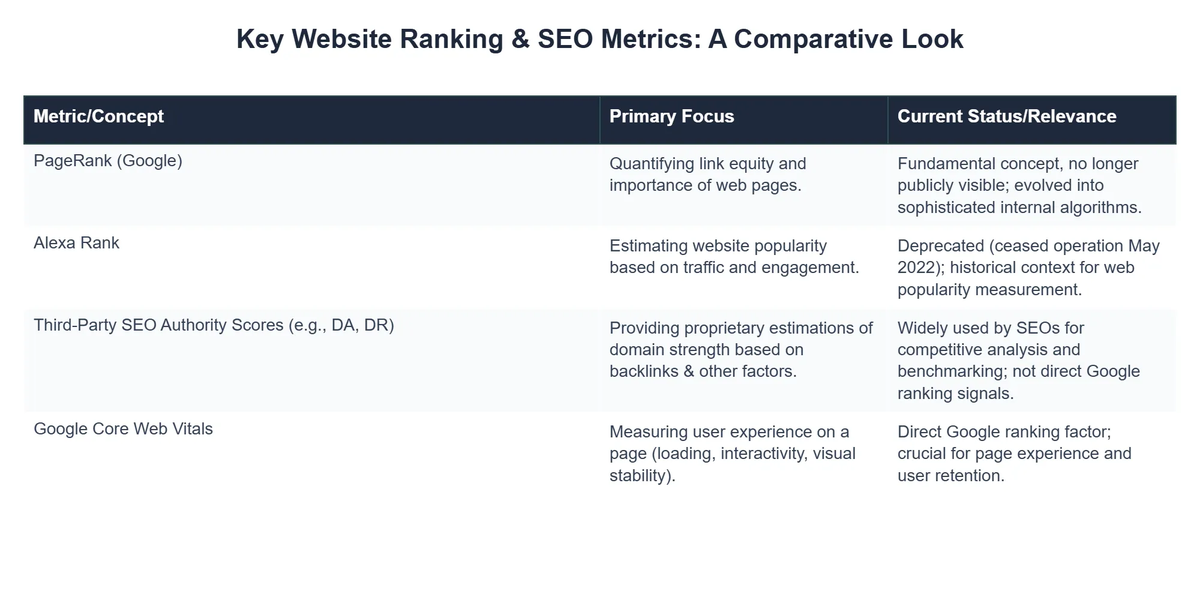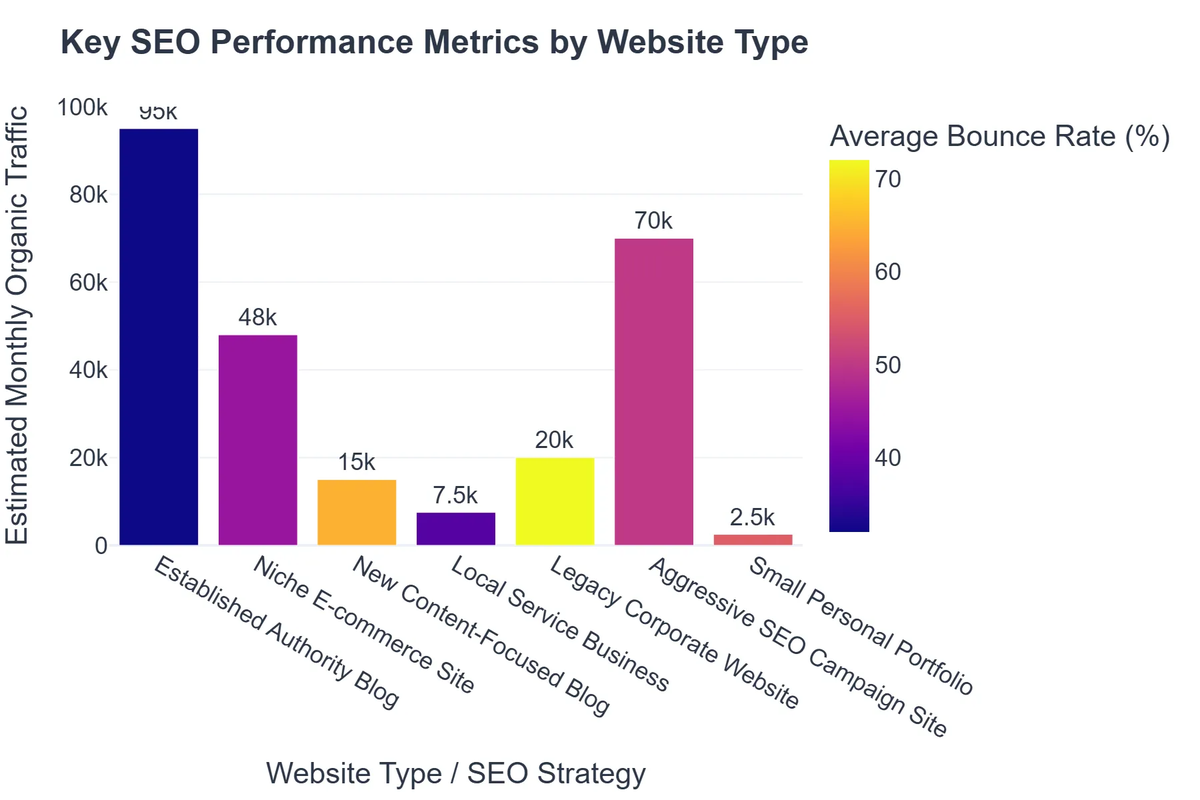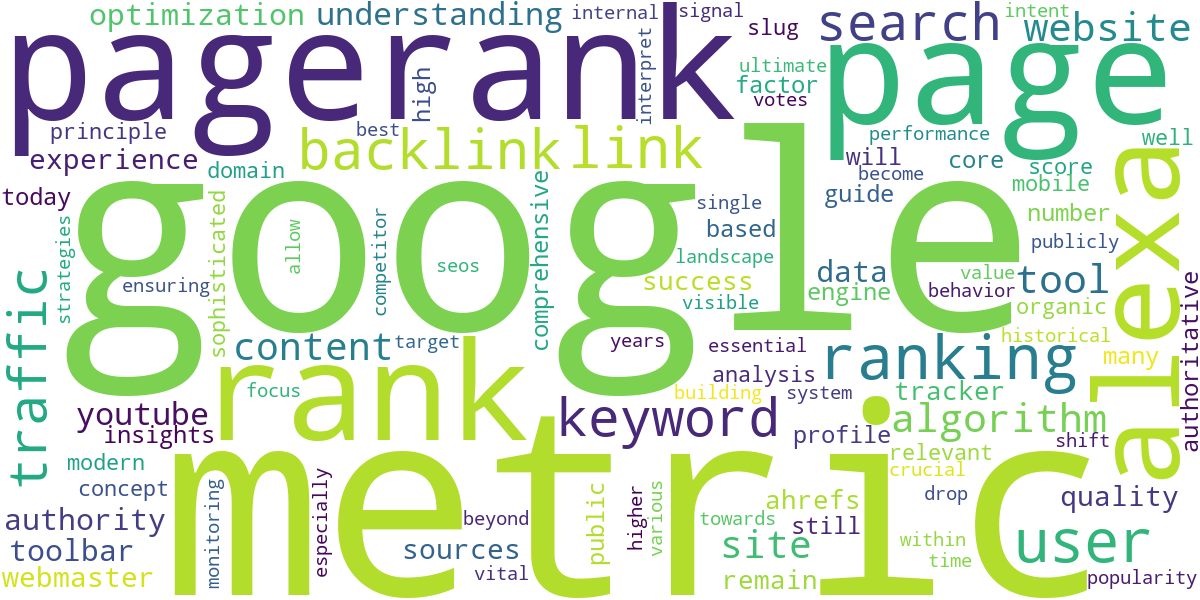Understanding PageRank, Google, Alexa, and SEO Metrics: A Comprehensive Guide
In the dynamic world of search engine optimization (SEO), understanding how search engines evaluate and rank websites is paramount. While algorithms constantly evolve, foundational concepts and key metrics remain crucial for digital success. This guide dives deep into historical and modern evaluation systems, from the legendary Google PageRank to the now-defunct Alexa Rank, and explores the essential SEO metrics that matter today.
💡 Key Takeaways
- PageRank’s foundational role in Google’s early ranking, despite its public deprecation.
- How Google’s evolving algorithms now encompass hundreds of ranking factors beyond simple links.
- The diminishing relevance of Alexa Rank in modern SEO compared to other data sources.
- Crucial SEO metrics to track for measuring website performance and organic growth.
“While PageRank public scores are gone, its core principle of link equity remains vital. True SEO success hinges on understanding how Google’s complex algorithms evaluate content and authority, far beyond any single metric.”
— Liam Carter, Senior SEO Strategist
Navigating the complexities of SEO requires a keen eye on performance indicators. Whether you’re a seasoned marketer or just starting your journey to master The Ultimate Guide to SEO (Search Engine Optimization), grasping these concepts will empower you to make data-driven decisions and achieve higher visibility.
In This Article
- → Understanding PageRank, Google, Alexa, and SEO Metrics: A Comprehensive Guide
- — 💡 Key Takeaways
- → The Evolution of PageRank: Google’s Foundational Algorithm
- — 💡 What Was Google PageRank?
- — The Decline of the Public PageRank Toolbar
- — Does PageRank Still Matter?
- → Beyond PageRank: Understanding Modern Google Ranking Factors
- — Core Web Vitals & User Experience (UX)
- — Content Quality & Relevancy
- — Backlinks & Topical Authority
- — Mobile-First Indexing
- → Alexa Rank: A Historical Perspective & Its Demise
- — What Was Alexa Rank?
- — Why Alexa Rank Was Problematic
- — The End of Alexa.com
- → Essential SEO Metrics & Tools in Today’s Landscape
- — Domain Authority (DA) & Domain Rating (DR)
- — Organic Traffic & Keyword Rankings
- — Backlink Profiles
- — Practical Tools for SEO Measurement
- → Leveraging Metrics for SEO Success
- — Monitoring Your Performance with a Page Rank Tracker
- — Competitive Analysis
- — Actionable Insights for Improvement
- → The Future of SEO Metrics: Adaptability is Key
- — Focus on User Intent and Experience
- — AI and Machine Learning’s Role
- — Monetizing Your YouTube Presence: Beyond Traditional SEO Metrics
- → Conclusion
The Evolution of PageRank: Google’s Foundational Algorithm
Long before Google dominated the search landscape, its founders, Larry Page and Sergey Brin, devised an ingenious algorithm called PageRank. This revolutionary system laid the groundwork for how search engines understand the authority and relevance of web pages.
💡 What Was Google PageRank?
At its core, Google PageRank was an algorithm that assigned a numerical weighting to each element of a hyperlinked set of documents, such as the World Wide Web, with the purpose of “measuring” its relative importance within the set. Think of it like a popularity contest, but where votes from more important pages counted for more.
- ✅ Link Equity: PageRank operated on the principle that links from one page to another were “votes of confidence.” The more links a page received, and especially the more authoritative those linking pages were, the higher its PageRank score.
- ➡️ Iterative Calculation: The algorithm worked iteratively, distributing “rank” from one page to another through links. A page’s PageRank was determined by the quantity and quality of inbound links from other pages.
- ⚙️ The Toolbar Era: For many years, Google publicly displayed a “Toolbar PageRank” score (from 0 to 10) that webmasters could see. This visible score became a highly sought-after metric for webmasters and SEOs alike.
The Decline of the Public PageRank Toolbar
While PageRank remains an integral part of Google’s internal ranking mechanisms, the public-facing Toolbar PageRank was last updated in 2013 and officially removed in 2016. Google realized that webmasters were overly focused on manipulating this single metric rather than creating genuinely valuable content and user experiences.
- 🚫 Misinterpretation: Many SEOs incorrectly believed that a high Toolbar PageRank was the only factor for ranking, leading to spammy link-building practices.
- 🔄 Algorithmic Secrecy: Google continuously updates its algorithms, incorporating hundreds of factors beyond PageRank. Keeping the exact weight and influence of various signals private allows them to maintain a more level playing field and combat spam.
Does PageRank Still Matter?
Absolutely, but not in the way it once did. The concept of PageRank – that links from authoritative sources pass value and influence a page’s standing – is still fundamental to how Google evaluates websites. It’s just no longer a publicly visible number for webmasters. Google’s internal systems still use sophisticated link analysis, constantly refining how they interpret and value these “votes.”
As former Google engineer Matt Cutts explained, while the public PageRank metric faded, the underlying principles of understanding link graphs continue to be vital to Google’s core algorithm. For more historical context, you can read insights directly from Google’s past on topics like estimating webmaster skew in Alexa metrics.
Beyond PageRank: Understanding Modern Google Ranking Factors
Today, Google’s ranking algorithm is a complex tapestry woven from hundreds of signals. While link authority (the spirit of PageRank) is still crucial, many other factors contribute to a page’s ability to rank high on Google.
Core Web Vitals & User Experience (UX)
Google heavily emphasizes user experience. Metrics like Core Web Vitals (Largest Contentful Paint, First Input Delay, Cumulative Layout Shift) directly impact rankings, especially for mobile searches. A fast, stable, and visually appealing website is rewarded.
Content Quality & Relevancy
High-quality, comprehensive, and relevant content is king. Google’s algorithms are increasingly sophisticated at understanding the true intent behind a search query and matching users with the most helpful and authoritative content. This includes proper Keyword Optimization for SEO: The Ultimate Guide to Ranking Higher.

Backlinks & Topical Authority
While the old public PageRank is gone, backlinks remain a cornerstone of SEO. High-quality, relevant backlinks from authoritative sites signal trust and expertise. Building a strong backlink profile is still a critical component of off-page SEO. For advanced strategies, explore Off-Page SEO & YouTube SEO Hacks: Advanced Strategies.
Mobile-First Indexing
Google primarily uses the mobile version of a site for indexing and ranking. Ensuring your website is responsive and performs well on mobile devices is no longer optional; it’s a fundamental requirement.
Alexa Rank: A Historical Perspective & Its Demise
For many years, Alexa.com, owned by Amazon, provided a global ranking of websites based on their traffic. It was often seen as an alternative or complementary metric to Google’s internal PageRank, especially for gauging general website popularity.
What Was Alexa Rank?
Alexa Rank estimated a website’s popularity relative to all other sites on the internet. A lower number indicated a more popular website. It was primarily calculated based on the traffic data from millions of users who had the Alexa Toolbar installed in their browsers, combined with data from various other sources.
- 📊 Global Ranking: Alexa provided a single number representing a website’s standing globally.
- 📈 Traffic-Based: Unlike PageRank, which focused on link equity, Alexa Rank was largely a traffic-based metric.
Why Alexa Rank Was Problematic
Despite its widespread use, Alexa Rank was often criticized for its inaccuracies and biases:
- ➡️ Data Skew: Its reliance on toolbar users meant that the data could be skewed towards demographics or professions more likely to use the toolbar (e.g., webmasters, SEOs).
- 📉 Limited Scope: It didn’t account for all internet traffic, leading to less accurate rankings for smaller or niche sites.
- 🚫 Manipulable: Some tried to artificially inflate their Alexa Rank through various means.
The End of Alexa.com
After operating for over 25 years, Amazon officially retired Alexa.com on May 1, 2022. This marked the end of an era for a metric many in the SEO and webmaster community had relied on, despite its flaws. As reported by sources like Coywolf News, the SEO community has since shifted focus entirely to more reliable and comprehensive data sources.
Essential SEO Metrics & Tools in Today’s Landscape
With the public disappearance of PageRank and the demise of Alexa Rank, modern SEO professionals rely on a diverse set of metrics and powerful tools to measure website performance and inform their strategies.
Domain Authority (DA) & Domain Rating (DR)
These are proprietary metrics developed by SEO tool providers (Moz’s DA and Ahrefs’ DR). They attempt to estimate the “ranking strength” of an entire domain based on its backlink profile and other factors, offering a proxy for the authority concept PageRank introduced.
Organic Traffic & Keyword Rankings
- 📈 Organic Traffic: The number of visitors who find your site through unpaid search results is the ultimate measure of SEO success.
- 🔎 Keyword Rankings: Tracking where your pages rank for target keywords is crucial. This shows which content is performing well and where improvements are needed. Tools like Ahrefs Rank Tracker are invaluable for monitoring your positions for thousands of keywords over time.
Backlink Profiles
Analyzing the quality and quantity of your backlinks, as well as those of your competitors, remains critical. Tools allow you to see referring domains, anchor text, and overall link quality.
Practical Tools for SEO Measurement
Today, a robust suite of SEO tools provides the data and insights necessary for effective optimization:

- ✅ Google Search Console: Essential for understanding how Google sees your site, identifying crawl errors, and seeing actual search queries that bring users to your site.
- ➡️ Google Analytics: Provides deep insights into user behavior on your site, traffic sources, conversions, and more.
- 💡 Ahrefs / Semrush / Moz: These all-in-one platforms offer comprehensive tools for keyword research, competitor analysis, backlink analysis, site audits, and rank tracking. For instance, an effective page rank tracker within Ahrefs can show you your current rankings for all your target keywords. If you’re looking for Best Keyword Research Tools for SEO Success, these are top contenders.
Leveraging Metrics for SEO Success
Collecting data is only half the battle. The true value lies in how you interpret and act upon these SEO metrics.
Monitoring Your Performance with a Page Rank Tracker
Regularly reviewing your keyword rankings, organic traffic, and backlink growth allows you to gauge the effectiveness of your SEO efforts. Using a dedicated page rank tracker like Ahrefs Rank Tracker helps you visualize trends, identify drops or gains, and prioritize optimization tasks.
Preview not available
Ahrefs Rank Tracker
Ahrefs Rank Tracker isn’t just about showing your positions; it’s your early warning system and growth accelerator. Monitor keyword performance with unparalleled accuracy, spot ranking fluctuations before they impact traffic, and track competitor movements to stay ahead. Its intuitive interface transforms complex data into actionable insights, allowing you to optimize campaigns, demonstrate ROI, and ultimately drive more qualified organic leads and sales. Essential for anyone serious about dominating search.
Competitive Analysis
Analyzing your competitors’ metrics (their estimated traffic, top keywords, backlink sources) can reveal opportunities you might be missing. Understanding their “SEO page rank” or authority metrics can help you benchmark your own progress.
Actionable Insights for Improvement
Metrics aren’t just for reporting; they’re for guiding action:
- ➡️ Low Rankings: If your target keywords aren’t ranking well, it might indicate a need for better content, more authoritative backlinks, or improved on-page optimization.
- 📈 Traffic Drops: A sudden drop in organic traffic could point to technical issues, algorithm updates, or lost backlinks.
- 🔗 Poor Backlink Profile: A high number of low-quality links suggests a need for a link audit and a strategy for acquiring stronger, more relevant links.
The Future of SEO Metrics: Adaptability is Key
SEO is an ever-evolving field. As search engines become more sophisticated, the metrics we prioritize will also shift. The core principle, however, remains consistent: provide the best possible experience and most relevant content to users.
Focus on User Intent and Experience
Metrics increasingly lean towards user behavior – dwell time, bounce rate, click-through rates. Google aims to satisfy user intent, and pages that do so effectively will naturally perform better.
AI and Machine Learning’s Role
AI is already deeply embedded in search algorithms, from understanding natural language to identifying spam. Future metrics will likely become even more nuanced, reflecting machine learning’s ability to interpret complex relationships between content, user behavior, and site authority.

Recommended Video
Monetizing Your YouTube Presence: Beyond Traditional SEO Metrics
While discussing website metrics, it’s also worth noting the unique landscape of video platforms. For creators asking “how to monetize your youtube page” or “how to monetize youtube page,” the metrics shift. Success on YouTube isn’t just about a “YouTube page rank” in the traditional sense, but about audience engagement, watch time, subscriber growth, and adherence to YouTube’s monetization policies (e.g., meeting subscriber and watch hours thresholds). Understanding your audience retention, average view duration, and traffic sources within YouTube Analytics becomes your primary “page rank checker” for video content.
The journey from the early days of Google PageRank to the sophisticated SEO metrics of today highlights a continuous evolution towards a more user-centric web. While single, publicly visible scores like PageRank and Alexa Rank are now relics of the past, the underlying principles of authority, relevance, and user experience remain paramount.
To succeed in modern SEO, focus on creating exceptional content, building a strong and natural backlink profile, ensuring a stellar user experience, and diligently monitoring a comprehensive suite of contemporary SEO metrics. Tools like Ahrefs Rank Tracker and insights from Google Search Console will be your compass in this ongoing voyage, ensuring your efforts translate into measurable online success.
Is PageRank still important for SEO?
While Google no longer publicly updates or displays PageRank scores, the underlying concept of link equity and authority remains a crucial ranking factor within its algorithms.
How does Alexa Rank compare to Google’s ranking factors?
Alexa Rank primarily indicates website popularity based on traffic, while Google uses a vast array of factors to determine search engine rankings, making Alexa less relevant for SEO.
What are the most important SEO metrics to monitor today?
Key metrics include organic traffic, keyword rankings, bounce rate, dwell time, conversion rate, and backlinks, providing a holistic view of performance.
Did Google’s algorithms replace PageRank entirely?
Google’s algorithms have evolved significantly, incorporating hundreds of signals beyond PageRank, which was just one component, albeit foundational.
Ahrefs Rank Tracker
Ready to take the next step? See how Ahrefs Rank Tracker can help you achieve your goals.





